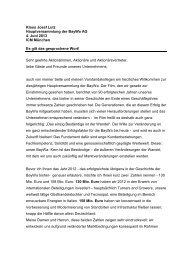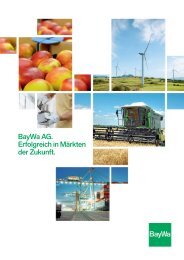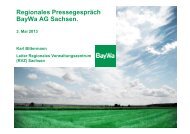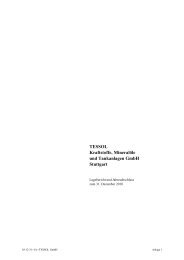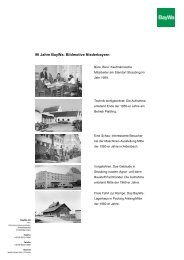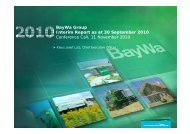BayWa AG Annual Report 2011
BayWa AG Annual Report 2011
BayWa AG Annual Report 2011
Create successful ePaper yourself
Turn your PDF publications into a flip-book with our unique Google optimized e-Paper software.
56<br />
Significant increase in the price<br />
of agricultural produce<br />
Demand for lubricants stronger<br />
Acceleration in Germany’s policy<br />
to promote alternative sources of<br />
energy<br />
3 • Management <strong>Report</strong> on the Company and the Group • Business and General Conditions<br />
Trends in the agriculture sector<br />
Compared with a year ago, the average prices of agricultural produce, particularly of grain, rape, fruit and milk,<br />
rose significantly in <strong>2011</strong>. At the end of the third quarter, the producer price index of agricultural produce was<br />
almost 12% above the level posted a year ago. In the case of important agricultural commodities, this price trend<br />
was buoyed by strong global demand and the rising price of energy. Due to the growing use of renewable primary<br />
materials to produce energy, prices in the energy market are increasingly forming a floor for the corresponding<br />
agricultural produce. Moreover, unfavourable weather conditions during the main harvest period in late summer<br />
and early autumn resulted in poor harvests in a number of regions. The global production volume of grain in the<br />
grain year 2010/11 came in at 2,200.3 million tons, which is 1.8% lower in comparison with the 2010 figure. At<br />
the same time, consumption climbed by 1.2% to 2,228.7 million tons, which depleted inventories by 28.4 million<br />
tons to 462.2 million tons. The total volume of grain harvested in Germany fell 5.7% short of the year-earlier level.<br />
Winter barley was particularly badly affected by the weather, with the yield per hectare declining by 14.9%. Seen<br />
from a regional standpoint, the yield trend in the south and west was better than in the north and east. Producer<br />
prices in the dairy industry climbed for the second year in a row, with dairy production up by around 2.4%. The<br />
production of meat is likely to have risen overall by between 1% and 2% in <strong>2011</strong>. A slight downturn in the volume of<br />
cattle farming was more than compensated by rising prices. Pig farming came under pressure in <strong>2011</strong> from higher<br />
feedstuff prices, on the one hand, and dioxin contamination of certain types of feedstuff on the other. As a result,<br />
producer prices fell to their lowest level for a number of years but staged a recovery as the year progressed. Poultry<br />
farming grew by approximately 3% in terms of volume in <strong>2011</strong>, accompanied by better prices. The purchase prices<br />
of agricultural operating resources also rose significantly overall by 8%. Above-average price hikes were recorded<br />
particularly for fertilisers, feedstuffs and energy as opposed to crop protection products where prices increases were<br />
moderate. The generally substantially higher income of farmers was, however, more than sufficient to compensate<br />
for higher costs. The German Farmers’ Association therefore anticipates an increase in net value added of 7% to<br />
€13.4 billion. Operating income per worker advanced by just under 10% to €24,600 in the calendar year <strong>2011</strong>, up<br />
from €22,500 in 2010. Agricultural machinery reported a record year with a revenue growth of more than 30% in<br />
<strong>2011</strong>. Strong demand for cutting-edge agricultural technology was driven firstly by the generally good selling prices<br />
for agricultural produce, and secondly by structural changes in the agriculture industry. For instance, the number of<br />
agricultural operations declined by another 2.3% in 2010 to 300,700 in contrast to the average area of land under<br />
cultivation which rose by 2.3% to 55.8 hectares. This trend is conducive to the increasing deployment of intelligent<br />
and process-driven agricultural equipment to enhance efficiency.<br />
Trends in the energy sector<br />
The determining influence on the heating business in <strong>2011</strong> was the high crude oil price. Having closed the year<br />
2010 at around USD95 per barrel, close to its peak for the year, the crude oil price entered another steep uptrend at<br />
the start of <strong>2011</strong>, which brought it to just under USD127 at the start of April. Although, by the beginning of October,<br />
the price had declined, displaying a great deal of volatility, from this level to USD100, it was significantly higher over<br />
the course of <strong>2011</strong> in a year-on-year comparison. Against this backdrop, and because of lower consumption due<br />
to the mild winter, demand remained modest. Despite positive economic influences and an uptrend in the stock of<br />
vehicles, the fuels business also reported marginal sales increases. As in 2010, the price policy of the large mineral<br />
oil companies remained geared to compensating the lower refinery margins through higher margins in other<br />
business lines, such as filling stations. Demand in the lubricants business continued to rise in <strong>2011</strong>, due in the main<br />
to the sustained positive development of the metal processing industry, particularly mechanical engineering.<br />
In the field of renewable energies, fundamental political decisions were made with the adoption of the Energy<br />
Concept 2050 by the German government and Bundestag in the autumn of 2010. Under this concept, the<br />
proportion of renewable energies in electricity production is to be raised to 80% in the period through to 2050, the<br />
overall consumption of energy halved and CO 2 emissions reduced by 80% to 95%. The nuclear disaster in Japan in<br />
March <strong>2011</strong> accelerated the turnaround in Germany’s energy policy through the retraction of extending the lifetime<br />
of existing nuclear power plants. All in all, the expansion of solar, wind power and biogas capacities is progressing<br />
apace and is being increasingly promoted by established energy utilities. Whereas wind farms and biogas plants<br />
generally involve large-scale commercial projects, the demand for photovoltaic systems is strongly influenced by<br />
private households. In this segment, the development of subsidising measures has a major impact on investment<br />
<strong>BayWa</strong> <strong>AG</strong> <strong>Annual</strong> <strong>Report</strong> <strong>2011</strong>



